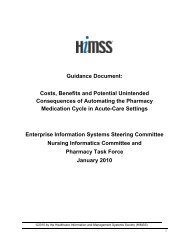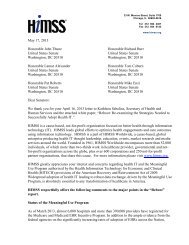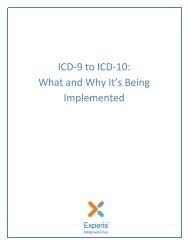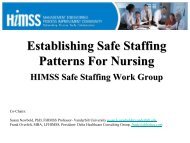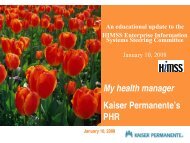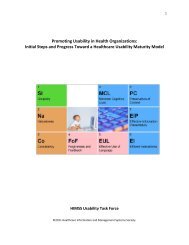Explaining the Technical Architecture of HIE - himss
Explaining the Technical Architecture of HIE - himss
Explaining the Technical Architecture of HIE - himss
Create successful ePaper yourself
Turn your PDF publications into a flip-book with our unique Google optimized e-Paper software.
<strong>Explaining</strong> <strong>the</strong> <strong>Technical</strong> <strong>Architecture</strong><br />
<strong>of</strong> Health Information Exchange<br />
HIMSS Health Information Exchange Toolkit Task Force<br />
<strong>Technical</strong> <strong>Architecture</strong> Workgroup (2011)
The HIMSS Definition <strong>of</strong><br />
Health Information Exchange<br />
A Health Information Exchange (<strong>HIE</strong>) assists with <strong>the</strong> transfer and sharing <strong>of</strong> health-related<br />
information that is typically stored in multiple organizations, while maintaining <strong>the</strong> context and<br />
integrity <strong>of</strong> <strong>the</strong> information being exchanged. 1 An <strong>HIE</strong> provides access and retrieval <strong>of</strong> patient<br />
information to authorized users in order to provide safe, efficient, effective, and timely patient<br />
care. Formal organizations have been created in a number <strong>of</strong> states and regions that provide<br />
technology, governance, and support for <strong>HIE</strong> efforts. Those formal organizations are termed<br />
Health Information Organizations (HIOs) or Regional Health Information Organizations (RHIOs).<br />
<strong>HIE</strong>s are formed by a collective group <strong>of</strong> stakeholders from a specific area or region to facilitate<br />
<strong>the</strong> electronic exchange <strong>of</strong> health-related information for <strong>the</strong> purpose <strong>of</strong> improving healthcare for<br />
a defined population. Thus, <strong>the</strong> <strong>HIE</strong> provides <strong>the</strong> ability for participating organizations to safely<br />
and securely share health information with authorized providers to improve and expedite <strong>the</strong><br />
clinical decision making process. An <strong>HIE</strong> is not an information system within a single<br />
organization, nor is it one that has a single directional flow <strong>of</strong> information. A true <strong>HIE</strong> involves<br />
multi-directional flow <strong>of</strong> information electronically between providers (hospitals, physicians,<br />
clinics, labs) and o<strong>the</strong>r sources <strong>of</strong> administrative or clinical information provided by consumers,<br />
health plans, employers, local, state or national organizations.<br />
© 2011 HIMSS 2
According to Wikipedia…<br />
Health Information Exchange (<strong>HIE</strong>) is defined as: 2<br />
The mobilization <strong>of</strong> healthcare information<br />
electronically<br />
across organizations<br />
within a region*, community, or hospital system.<br />
* The “region” could be city, county, state, nation, or global<br />
© 2011 HIMSS 3
In More <strong>Technical</strong> Terms…<br />
Adapted from Claude Shannon’s Ma<strong>the</strong>matical Model <strong>of</strong> Communication 3<br />
© 2011 HIMSS 4
Health Information Exchange<br />
© 2011 HIMSS 5
Choke Points<br />
While <strong>the</strong> process may appear simple, <strong>the</strong>re are many choke points along<br />
<strong>the</strong> health information exchange highway.<br />
These choke points can come in many forms such as roadblocks,<br />
obstacles, and o<strong>the</strong>r things that become obstacles in moving forward.<br />
Choke points can also be called<br />
Health Information Exchange Stop Lights.<br />
© 2011 HIMSS 6
Health Information Exchange Stop Lights<br />
Electronic health information is stored in many different ways<br />
(and s<strong>of</strong>tware languages).<br />
Communicating (exchanging) health information requires<br />
shared understanding <strong>of</strong> what information will be shared and<br />
what it means.<br />
Distances are not a barrier for health information exchange,<br />
BUT ensuring that <strong>the</strong> information is secure along <strong>the</strong> <strong>HIE</strong>way<br />
requires diligence and compliance with HIPAA and privacy laws,<br />
regulations, policies, and procedures – at all points from A to B<br />
and anywhere that health information may stop, detour, or<br />
o<strong>the</strong>rwise travel.<br />
© 2011 HIMSS 7
Overcoming Choke Points<br />
Overcoming <strong>the</strong> choke points is relatively easy. The hard part is<br />
COMMUNICATION:<br />
WHAT will be communicated<br />
HOW it will be communicated<br />
WHERE it will be communicated<br />
WHEN it will be communicated<br />
WHY it will be communicated<br />
EXCHANGE = COMMUNICATION<br />
© 2011 HIMSS 8
Exploring <strong>the</strong> Stop Lights (Choke Points)<br />
Electronic health information is stored in many different<br />
ways (and s<strong>of</strong>tware languages).<br />
• Proprietary or custom code and applications<br />
Multiple languages: Java, MUMPS, XML, HTML, C++, C#<br />
• Databases (rarely are two ever <strong>the</strong> same) or data sets<br />
Different types: RDBMS, SQL, Oracle, SAP, Java<br />
• Encounters, notes, images, labs, medications, referrals, and allergies<br />
may not be stored in <strong>the</strong> same location(s), s<strong>of</strong>tware language, or data<br />
types.<br />
We are assuming current health information is stored electronically, even in an “<strong>of</strong>fice” file,<br />
but paper records and paper-based data (such as fax) is widely used.<br />
© 2011 HIMSS 9
Exploring <strong>the</strong> Stop Lights (Choke Points)<br />
Communicating (exchanging) health information requires<br />
shared understanding <strong>of</strong> what information will be shared<br />
and what it means.<br />
• Health Information Exchange begins with “knowing” <strong>the</strong> patient (in <strong>the</strong><br />
computer systems)<br />
Master Patient Index, sharing basic personal and demographic data<br />
• Agreeing on format, method, and techniques for exchanging health<br />
information<br />
E.g., common standards for names <strong>of</strong> things (medications, lab tests, lab results)<br />
• The mechanisms for exchanging health information (secure electronic<br />
mail, Web services, etc.)<br />
© 2011 HIMSS 10
Exploring <strong>the</strong> Stop Lights (Choke Points)<br />
Distances are not a barrier for health information<br />
exchange, BUT ensuring that <strong>the</strong> information is secure<br />
along <strong>the</strong> <strong>HIE</strong>way requires diligence and compliance with<br />
HIPAA and privacy laws, regulations, policies, and<br />
procedures – at all points from A to B and anywhere that<br />
health information may stop, detour, or o<strong>the</strong>rwise travel.<br />
• HIPAA standards for privacy are really only <strong>the</strong> beginning.<br />
• Maintaining secure information processing standards (and meeting<br />
those standards) protects everyone in <strong>the</strong> health information exchange.<br />
• Creating a “fabric <strong>of</strong> trust” is <strong>the</strong> basis for a meaningful health<br />
information exchange.<br />
© 2011 HIMSS 11
HEALTH INFORMATION EXCHANGE<br />
IS HARD<br />
© 2011 HIMSS 12
Introducing <strong>the</strong> Players<br />
PATIENTS<br />
Healthcare customers and consumers.<br />
VENDORS<br />
PROVIDERS<br />
Technology firms that connect doctors and o<strong>the</strong>r healthcare providers with<br />
patients. While <strong>the</strong>re is some overlap with <strong>the</strong> o<strong>the</strong>r vendors group below,<br />
<strong>the</strong>se are two distinct groups and do not always include <strong>the</strong> same type <strong>of</strong><br />
vendors with similar vendor products.<br />
Doctors, hospitals, clinics – <strong>the</strong> people or organizations that actually provide<br />
healthcare to patients.<br />
VENDORS<br />
PAYERS<br />
Technology people that connect <strong>the</strong> payers (insurance, government, etc.) with<br />
<strong>the</strong> providers.<br />
Patients rarely pay directly for <strong>the</strong> majority <strong>of</strong> <strong>the</strong>ir healthcare services.<br />
Payers, or more accurately payer groups, pay <strong>the</strong> providers for <strong>the</strong> healthcare<br />
services rendered to <strong>the</strong> patient. Essentially, PATIENTS pay PAYERS and<br />
PAYERS pay PROVIDERS – and at some point <strong>the</strong>y all must “talk” to each<br />
o<strong>the</strong>r.<br />
© 2011 HIMSS 13
Communication Transactions<br />
Claude Shannon’s ma<strong>the</strong>matical model <strong>of</strong> communication can help to explain <strong>the</strong><br />
complexity in health information exchanges:<br />
“n” is <strong>the</strong> number <strong>of</strong> participants in <strong>the</strong> communication<br />
transaction (or health information exchange)<br />
“N” is <strong>the</strong> total number <strong>of</strong> communication channels.<br />
Derived from Shannon’s influential Ma<strong>the</strong>matical Theory <strong>of</strong> Communication 3<br />
© 2011 HIMSS 14
Communication Transactions<br />
within <strong>the</strong> <strong>HIE</strong> Environment<br />
According to <strong>the</strong> formula<br />
n= 5 (participants in <strong>the</strong> communication exchange)<br />
Answer: 10 total communication channels<br />
This does not work as neatly with<br />
Healthcare and Information Exchanges<br />
© 2011 HIMSS 15
Communication Considerations<br />
PATIENTS<br />
May equal 1, but <strong>the</strong>re’s likely a spouse, parent, next <strong>of</strong> kin, or significant o<strong>the</strong>r.<br />
VENDORS<br />
PROVIDERS<br />
VENDORS<br />
PAYERS<br />
On average, <strong>the</strong>re may be 4 to 5 information systems and health information<br />
systems connecting patients with providers, including electronic mail, Internet<br />
access, and o<strong>the</strong>r “<strong>of</strong>fice” systems.<br />
Providers may use 3 to 4 different health information systems in <strong>the</strong> typical<br />
electronic health record.<br />
Connecting <strong>the</strong> providers to <strong>the</strong> payers (if not <strong>the</strong> patients) may include<br />
ano<strong>the</strong>r 3 to 5 information and health information systems.<br />
Payer information and health information systems add ano<strong>the</strong>r 4 to 5 systems<br />
to <strong>the</strong> process.<br />
The total number <strong>of</strong> information and health information systems in this example could easily be twenty (20)<br />
without taking into account <strong>the</strong> external channels within <strong>HIE</strong> initiatives.<br />
© 2011 HIMSS 16
Systems<br />
System: 4<br />
(n) a collection <strong>of</strong> components organized to accomplish a<br />
specific function or set <strong>of</strong> functions.<br />
For example, <strong>the</strong> Department <strong>of</strong> Defense’s EHR (AHLTA) is made up <strong>of</strong> modules<br />
(lab, pharm, rad, etc.). Those modules, or components, are <strong>the</strong> “systems” that must<br />
communicate with each o<strong>the</strong>r to provide documentation and clinical decision support<br />
(more components, modules, “systems”) for providing <strong>the</strong> actual healthcare.<br />
So in <strong>the</strong> previous counting exercise, what we’re really talking about are <strong>the</strong><br />
COMPONENTS within a system – just calling <strong>the</strong>m systems keeps things simpler.<br />
© 2011 HIMSS 17
New Math<br />
190 (or more) communication channels in a health information exchange –<br />
and that’s still within one “closed” internal exchange system, not sharing<br />
with o<strong>the</strong>r external or third party providers, healthcare organizations or<br />
trading partners.<br />
© 2011 HIMSS 18
What It Really Looks Like<br />
• Financial Management Systems<br />
• Enterprise Resource Planning (ERP)<br />
• Earned Value Management<br />
• Decision Support Systems (DSS)<br />
PATIENTS VENDORS PROVIDERS VENDORS PAYERS<br />
GOVERNMENT<br />
• Electronic Health Record (EHR)<br />
• Electronic Medical Record (EMR)<br />
• Personal Health Record (PHR)<br />
• Computerized Practitioner Order Entry<br />
(CPOE)<br />
• ePrescribing & Pharmacy Applications<br />
• Ancillary Systems (lab, imaging, etc.)<br />
• Master Patient Index (MPI)<br />
• Master Provider Index (MPI)<br />
• Clinical Decision Support Systems (CDSS)<br />
• CMS<br />
• HHS<br />
• SSA<br />
• VA<br />
• DoD<br />
© 2011 HIMSS 19
ONE PROVIDER, HOSPITAL, CLINIC, ACCOUNTABLE CARE<br />
ORGANIZATION, ETC.<br />
Health<br />
Information<br />
Exchange<br />
Health Information<br />
Exchange<br />
A Graphic Example<br />
ONE PROVIDER, HOSPITAL, CLINIC, ACCOUNTABLE CARE<br />
ORGANIZATION, ETC.<br />
© 2011 HIMSS 20
New Math (revised for <strong>HIE</strong>)<br />
Now we have 780 communication channels…and we still haven’t included<br />
<strong>the</strong> inner workings <strong>of</strong> <strong>the</strong> actual health information exchange.<br />
Point: <strong>HIE</strong> will have many connections that will increase over time as <strong>the</strong><br />
business, customers, and trading partners expand.<br />
© 2011 HIMSS 21
Health Information Exchange<br />
TECHNICAL ARCHITECTURE(S)<br />
© 2011 HIMSS 22
What do you want to do?<br />
• Simple<br />
Send or receive “simple” health information (e.g., e-prescribing*).<br />
• Complex<br />
Send, receive, and update more “complex” health information<br />
(e.g., consults,* referrals,* diagnostic imaging*).<br />
* NOTE: These are still pretty complicated processes, and <strong>the</strong> key differentiator is whe<strong>the</strong>r you want<br />
to make <strong>the</strong> health information computable (editable) on both ends.<br />
© 2011 HIMSS 23
Usable Examples<br />
• The Direct Project<br />
Simple<br />
Best for small practices, clinics<br />
You likely already have <strong>the</strong> hardware in place to do this (for <strong>the</strong> most part)<br />
• The Connect Project<br />
Complex<br />
Best for larger clinics, hospitals<br />
Definitely requires some new hardware, s<strong>of</strong>tware, and a lot <strong>of</strong> cooperation<br />
(and communication)<br />
© 2011 HIMSS 24
Hidden Costs<br />
Actual costs will vary, and while this list is certainly not comprehensive,<br />
<strong>the</strong>se are some “hidden” costs that may not be immediately obvious:<br />
Design<br />
Implementation<br />
Change Management<br />
Maintenance<br />
© 2011 HIMSS 25
Costs (hidden or o<strong>the</strong>rwise)<br />
• Design: S<strong>of</strong>tware, hardware, and making it all work toge<strong>the</strong>r<br />
• Implementation: Making things actually happen<br />
• Change Management: Workflow, processes, policies and procedures<br />
that impact both organizational management and processes. The scope<br />
<strong>of</strong> <strong>the</strong>se changes can be traumatic (even in a Level III facility).<br />
• Maintenance: Anticipating, planning, and budgeting to keep <strong>the</strong> health<br />
information exchange going needs to begin at <strong>the</strong> time you decide to<br />
kick-<strong>of</strong>f <strong>the</strong> project (don’t wait until <strong>the</strong> end <strong>of</strong> initial development to<br />
consider this).<br />
© 2011 HIMSS 26
THE NATIONWIDE HEALTH<br />
INFORMATION NETWORK (NWHIN)<br />
© 2011 HIMSS 27
Community Regional State <br />
Nationwide Global<br />
Community Health Information Network (CHIN)<br />
Early (1990s) series <strong>of</strong> initiatives linking health organizations within a<br />
“community” (city).<br />
Regional Health Information Organizations (RHIOs)<br />
The basic building blocks <strong>of</strong> health information exchange, RHIOs are regional<br />
(local to each o<strong>the</strong>r) health organizations that share or exchange health<br />
information.<br />
Local: Expands <strong>the</strong> CHIN-type with a better governance structure<br />
Statewide: Typically a government-sponsored initiative to implement RHIOs in a state<br />
Nationwide Health Information Network (NwHIN)<br />
HHS/ONC effort to bring toge<strong>the</strong>r <strong>the</strong> RHIOs and o<strong>the</strong>r health information<br />
networks into a more manageable, more sustainable, and better organized<br />
health information exchange network.<br />
© 2011 HIMSS 28
The Spectrum <strong>of</strong> Exchange (Basic Steps)<br />
• Simple Direct<br />
• Less Simple RHIO<br />
• Really Complex Connect<br />
© 2011 HIMSS 29
Basic Steps<br />
Simple (Direct)<br />
Direct: Secure electronic email used as <strong>the</strong> transport for health information exchange<br />
© 2011 HIMSS 30
Intermediate Level Steps<br />
Less Simple (RHIO)<br />
RHIO: begins <strong>the</strong> path to creating more sophisticated health information exchanges at a<br />
local or regional level.<br />
© 2011 HIMSS 31
Basic to Complex Steps<br />
Really Complex (Connect)<br />
Connect: complex “network <strong>of</strong> networks” using push-pull model <strong>of</strong> health information<br />
exchange within a trusted community (also configurable so that you don’t have to “trust”<br />
everyone – just who you want to, and can, Connect with).<br />
© 2011 HIMSS 32
Direct Summary<br />
• Direct is simply a “push” or sending <strong>of</strong> health information from a sender to a<br />
receiver.<br />
• The focus is on <strong>the</strong> secure transport <strong>of</strong> <strong>the</strong> health information (from Point A to<br />
Point B).<br />
• Feedback would be ano<strong>the</strong>r “push,” so <strong>the</strong>re is not a continuous loop or<br />
bidirectional exchange <strong>of</strong> health information.<br />
• That’s it!<br />
© 2011 HIMSS 33
HISPs<br />
Health Information Service Provider(s) (n):<br />
Think <strong>of</strong> <strong>the</strong>se as similar to your Internet Service Provider. HISPs are <strong>the</strong><br />
people, services, and technology that make health information exchanges<br />
possible (i.e., <strong>the</strong> vendors, but sometimes more than that).<br />
© 2011 HIMSS 34
RHIO Summary<br />
Regional Health Information Organizations are <strong>the</strong> basic building<br />
blocks <strong>of</strong> a larger health information exchange.<br />
=<br />
© 2011 HIMSS 35
Connect Summary<br />
• Connect is a gateway to <strong>the</strong> Nationwide Health Information Network.<br />
• Helps healthcare entities connect <strong>the</strong>ir existing healthcare information systems<br />
to <strong>the</strong> Nationwide Health Information Network.<br />
• Fully functional out-<strong>of</strong>-<strong>the</strong>-box but allows customization in order to meet <strong>the</strong><br />
organizational needs and uniqueness <strong>of</strong> different healthcare information<br />
systems.<br />
• Based on service-oriented architecture design principles and Web-services<br />
interfaces.<br />
• Individual components can be replaced by custom s<strong>of</strong>tware that adheres to <strong>the</strong><br />
Web services interfaces.<br />
• Hosted on different hardware and s<strong>of</strong>tware platforms, as well as different<br />
programming languages.<br />
© 2011 HIMSS 36
Push / Pull<br />
Push (a.k.a. “publish”)<br />
Send health information to an external health information recipient (ano<strong>the</strong>r<br />
provider, a payer, etc.)<br />
Pull (a.k.a. “subscribe”)<br />
Requesting health information for a patient as ei<strong>the</strong>r a provider or payer<br />
NwHIN (and health information exchange) supports push and pull activities<br />
© 2011 HIMSS 37
Summary<br />
• Connect is a specific solution for exchanging health information (policies and<br />
standards)<br />
• Allows individual providers, payers, and potentially patients to “Connect” to one<br />
ano<strong>the</strong>r.<br />
• Using Web services (simply, exposing computer capabilities over <strong>the</strong> Internet),<br />
Connect implements a Service-Oriented <strong>Architecture</strong> (SOA).<br />
• SOA allows for a modular and evolutionary “system <strong>of</strong> systems” to plug into o<strong>the</strong>r<br />
modular and evolutionary “systems <strong>of</strong> systems” using a common, shared, and open<br />
source set <strong>of</strong> standards.<br />
• SOA creates a “network <strong>of</strong> networks.”<br />
© 2011 HIMSS 38
An Overview<br />
SERVICE-ORIENTED ARCHITECTURE<br />
(SOAS)<br />
© 2011 HIMSS 39
© 2011 HIMSS 40
What Is SOA?<br />
Service-Oriented <strong>Architecture</strong>: 5<br />
• SOA is a medium for exchange <strong>of</strong> value between independently acting<br />
participants;<br />
• Participants (and stakeholders in general) have legitimate claims to<br />
ownership <strong>of</strong> resources that are made available via <strong>the</strong> SOA; and<br />
• The behavior and performance <strong>of</strong> <strong>the</strong> participants are subject to rules <strong>of</strong><br />
engagement which are captured in a series <strong>of</strong> policies and contracts.<br />
© 2011 HIMSS 41
And…<br />
• SOA is a set <strong>of</strong> standards and practices for exchanging health<br />
information – emphasis on <strong>the</strong> exchange.<br />
• Patient information remains <strong>the</strong> property <strong>of</strong> <strong>the</strong> patient – consent<br />
determines how and with whom <strong>the</strong> information may be exchanged.<br />
• SOA really orchestrates many different systems (computers,<br />
applications, etc.) to act like a single “system <strong>of</strong> systems” –<br />
governance, policies, and procedures enforce how all this<br />
communication occurs.<br />
© 2011 HIMSS 42
HEALTH INFORMATION EXCHANGE<br />
AS SOA<br />
© 2011 HIMSS 43
Connect Core Services 6 (An SOA “Stack”)<br />
Consumer Services<br />
Consumer Preferences Pr<strong>of</strong>ile<br />
Query Audit Log<br />
Information<br />
Exchange Services<br />
Patient<br />
Discovery<br />
Health Information Event<br />
Messaging<br />
Query for<br />
Documents<br />
Retrieve<br />
Documents<br />
Authorized Case Follow-up<br />
Infrastructure<br />
Services<br />
N<strong>HIE</strong> Services Registry<br />
Messaging Platform<br />
Authorization Framework<br />
© 2011 HIMSS 44
Consumer Services<br />
Consumer Preferences Pr<strong>of</strong>ile<br />
Query Audit Log<br />
• Consumer Preferences Pr<strong>of</strong>ile<br />
• Acknowledge HIPAA rights<br />
• Consent for health information exchange (and any limits)<br />
• Query Audit Log<br />
• A mechanism to track who’s looking for what in someone’s records<br />
(where, when, how, and maybe why, too)<br />
© 2011 HIMSS 45
Information Exchange Services<br />
Patient<br />
Discovery<br />
Query for<br />
Documents<br />
Retrieve<br />
Documents<br />
Health Information Event<br />
Messaging<br />
Authorized Case Follow-up<br />
• Patient Discovery<br />
Keeping <strong>the</strong> right patients with <strong>the</strong> right data<br />
• Query for Documents<br />
Search protocols, and how those searches are done and recorded<br />
• Retrieve Documents<br />
How documents and records will be returned from those searches done in<br />
“Query for Documents”<br />
• Health Information Event Messaging<br />
A “publish / subscribe” mechanism to send or retrieve health information<br />
• Authorized Case Follow-Up<br />
The processes <strong>of</strong> reidentifying psuedomized data or records<br />
© 2011 HIMSS 46
Infrastructure Services<br />
N<strong>HIE</strong> Services Registry<br />
Authorization Framework<br />
Messaging Platform<br />
• N<strong>HIE</strong> Services Registry<br />
The list (registry) <strong>of</strong> connected participants in a Health Information Exchange –<br />
this is what allows you to find o<strong>the</strong>r “players,” and for <strong>the</strong>m to find you<br />
• Authorization Framework<br />
The patient’s parameters for health information exchange (what <strong>the</strong>y’ll share and what <strong>the</strong>y<br />
won’t), similar to but more comprehensive than HIPAA<br />
• Messaging Platform<br />
The systems or components that permit health information exchange<br />
© 2011 HIMSS 47
The Core Services 7 Come Toge<strong>the</strong>r<br />
Transaction Pr<strong>of</strong>iles<br />
Utilize exchange patterns for specific transactions<br />
CMS CARE<br />
Doc Submission<br />
CDC GIPSE<br />
<strong>HIE</strong>M<br />
MITA Eligibility<br />
Verification<br />
Patient<br />
Discovery<br />
Discovery and Information Exchange Services<br />
Rely on foundations to enable exchange patterns<br />
Discovery<br />
Services<br />
Registry<br />
Query &<br />
Retrieve Docs<br />
Pull<br />
Eligibility<br />
Verification<br />
Push<br />
Doc<br />
Submission<br />
Pub/Sub<br />
Messaging, Security, & Privacy Foundations<br />
Enable private, secure, and interoperable communication <strong>of</strong> health information<br />
<strong>HIE</strong>M<br />
Designates Pilot Use<br />
Messaging<br />
Platform<br />
Authorization<br />
Framework<br />
© 2011 HIMSS 48
Connect Gateway<br />
Adapter<br />
An SOA Is Born!<br />
Your Existing Health<br />
Information System<br />
Patient Identity<br />
Proprietary<br />
Interface<br />
Master Patient<br />
Index<br />
Health<br />
Data<br />
Custom<br />
Interface<br />
Health<br />
Information<br />
Exchange<br />
Decision<br />
Proprietary<br />
Interface<br />
Exchange<br />
Policies<br />
Disclosure<br />
History<br />
Custom<br />
Interface<br />
Audit Logs<br />
Future Services<br />
• Terminology Mapping<br />
• Document Viewers<br />
• Clinical Decision Support<br />
• O<strong>the</strong>r<br />
© 2011 HIMSS 49
Connect Gateway<br />
Adapter<br />
Connect On-ramps to <strong>the</strong> NwHIN 8<br />
Locate Patients<br />
Your Existing Health<br />
Information System<br />
Locate/Retrieve<br />
Health Documents<br />
Patient<br />
Identity<br />
Proprietary<br />
Interface<br />
Master Patient<br />
Index<br />
Publish/Subscribe<br />
to Data Feed<br />
Health<br />
Data<br />
Custom<br />
Interface<br />
Health<br />
Information<br />
O<strong>the</strong>r Health<br />
Organizations<br />
Retrieve<br />
Disclosure<br />
History<br />
Exchange<br />
Decision<br />
Proprietary<br />
Interface<br />
Exchange<br />
Policies<br />
Locate Health<br />
Systems/Services<br />
Disclosure<br />
History<br />
Custom<br />
Interface<br />
Audit Logs<br />
NHIN Conventions<br />
Framework for Authorization,<br />
Security, Privacy<br />
Future Services<br />
• Terminology Mapping<br />
• Document Viewers<br />
• Clinical Decision Support<br />
• O<strong>the</strong>r<br />
External NHIN API<br />
Internal Connect API<br />
Proprietary/Custom Interface<br />
© 2011 HIMSS 50
A Deep Dive into <strong>the</strong> Basics <strong>of</strong> Health Information Exchange<br />
(<strong>the</strong> Verb)<br />
ARCHITECTURAL DETAILS<br />
© 2011 HIMSS 51
Searching for Patients<br />
Integrating <strong>the</strong> Healthcare Enterprise (IHE) Pr<strong>of</strong>ile: PDQ 9 , Patient Demographics Query 10<br />
© 2011 HIMSS 52
Patients – Finding <strong>the</strong> Right Patient<br />
Integrating <strong>the</strong> Healthcare Enterprise (IHE) Pr<strong>of</strong>ile: PIX, Patient Identifier Cross-Referencing<br />
© 2011 HIMSS 53
Found a Patient…Share a Patient?<br />
Using <strong>the</strong> IHE pr<strong>of</strong>iles PDQ and PIX, it is possible to search within<br />
“networks <strong>of</strong> networks” (RHIO, NwHIN, etc.) to select and prepare a<br />
patient’s health information for exchange – send <strong>the</strong> data from Point A to<br />
Point B.<br />
© 2011 HIMSS 54
Responding<br />
Gateway<br />
Requesting<br />
Gateway<br />
Finding a Patient in a Health Information<br />
Exchange (XCPD - Cross Community Patient Discovery)<br />
act Inbound – Receive XCPD message<br />
Yes<br />
Adapter I/F<br />
Receives XCPD<br />
request<br />
Invoke audit log<br />
Yes<br />
Service<br />
enabled?<br />
Yes<br />
Passthrough<br />
mode<br />
No<br />
Invoke<br />
Policy<br />
Engine?<br />
Establish Patient<br />
Correlation<br />
Yes<br />
No<br />
Patient ID<br />
in request<br />
message?<br />
Query MPI<br />
Yes<br />
Yes<br />
Demographics<br />
Send<br />
demographics<br />
and patient id<br />
No<br />
No<br />
Invoke<br />
policy<br />
engine?<br />
Yes<br />
Single<br />
match<br />
found?<br />
Demographics and<br />
patient id<br />
Send empty msg<br />
No<br />
No<br />
Send request<br />
message<br />
Receive<br />
response<br />
message<br />
Empty message<br />
Activity Initial<br />
© 2011 HIMSS 55
Responding<br />
Gateway<br />
Initiating Gateway<br />
Sending Patient Information Through <strong>the</strong><br />
Health Information Exchange (XDR - “Push”)<br />
act Outbound<br />
Activity Initial<br />
Initiate XDR<br />
request message<br />
Receive XDR<br />
request message<br />
Invoke audit log<br />
Create XDR<br />
message<br />
Invoke audit log<br />
to log request<br />
Get Connection info<br />
from Connection<br />
manager<br />
Yes<br />
Policy<br />
check<br />
passed?<br />
Invoke policy<br />
engine<br />
Send XDR request<br />
Activity Final<br />
No<br />
Receive XDR<br />
request<br />
Send Ack to<br />
initiating gateway<br />
© 2011 HIMSS 56
Who, What, Where, When, Why, and How…as technical architecture<br />
THE JOURNALISM OF <strong>HIE</strong>S AND<br />
DIRECT PROJECT<br />
© 2011 HIMSS 57
Communication<br />
Let’s explore this in a little more detail:<br />
WHAT will be communicated<br />
HOW it will be communicated<br />
WHERE it will be communicated<br />
WHEN it will be communicated<br />
WHY it will be communicated<br />
© 2011 HIMSS 58
Who? (Examples 11 )<br />
EHR VENDORS<br />
ONC-APPROVED STATE PLANS<br />
4Medica<br />
Aprima Medical<br />
S<strong>of</strong>tware, Inc.<br />
Allscripts<br />
Care360<br />
Cerner<br />
Corporation<br />
CPSI<br />
eClinicalWorks<br />
e-MDs<br />
Epic<br />
GE Healthcare<br />
Greenway<br />
HealthyCircles<br />
MD-IT<br />
Med3000<br />
MEDgle<br />
NextGen<br />
OpenEMR<br />
Polaris<br />
RelayHealth<br />
Sage Healthcare<br />
Division<br />
Siemens<br />
Sunquest<br />
Information<br />
Systems, Inc.<br />
WorldVistA<br />
Alabama<br />
California<br />
Florida<br />
Illinois<br />
Iowa<br />
Kentucky<br />
Minnesota<br />
Missouri<br />
Montana<br />
New Hampshire<br />
New Jersey<br />
North Carolina<br />
Ohio<br />
Oregon<br />
Rhode Island<br />
South Carolina<br />
Texas<br />
Vermont<br />
West Virginia<br />
Wisconsin<br />
Indiana Health Information<br />
Exchange<br />
Delaware Health Information<br />
Network<br />
Health Information Network <strong>of</strong><br />
South Texas (HINST)<br />
RedwoodMedNet<br />
The Bronx RHIO<br />
<strong>HIE</strong>S AND HIOS<br />
MedVa<br />
Utah Health Information<br />
Network<br />
SEMH<br />
Colorado Health Information<br />
Exchange<br />
Nor<strong>the</strong>ast Kentucky RHIO<br />
Rochester RHIO<br />
SAFEHealth<br />
MiHIN Shared Services<br />
LCF Research/NMHIC<br />
NEHII<br />
SFHEX<br />
Michigan Health Connect<br />
© 2011 HIMSS 59
What?<br />
DIRECT Reference Implementation 12<br />
© 2011 HIMSS 60
Where?<br />
2010 – 2011 Direct Project Pilot Sites 13<br />
Private Practices Hospitals State/Federal Agencies<br />
• Minneapolis – Hennepin County Medical Center<br />
• New York – Hudson Valley<br />
• Rhode Island – Rhode Island Quality Institute<br />
• Tennessee – CareSpark and Dept <strong>of</strong> Veterans Affairs<br />
• California – Redwood MedNet<br />
• Connecticut – Middlesex Hospital and Community Health Center, Inc.<br />
• Texas – South Texas (a lot <strong>of</strong> players in this one)<br />
• Missouri – Heartland Regional Medical Center (St. Joseph)<br />
© 2011 HIMSS 61
When?<br />
IMPORTANT: before health information can be exchanged, patient<br />
consent must be obtained. There are two models in use today:<br />
• “opt in” – requires patient consent before health information may be<br />
used in <strong>the</strong> health information exchange<br />
• “opt out” – requires patient consent to limit or restrict health information<br />
within <strong>the</strong> health information exchange<br />
• Push (publish): Direct essentially sends health information from Point<br />
A to Point B<br />
• Pull (subscribe): Within an <strong>HIE</strong> Point, can look for pertinent health<br />
information for its patients; <strong>the</strong>n once health information is pushed out<br />
or published, <strong>the</strong> subscribing participant pulls it in<br />
• Toge<strong>the</strong>r: Complex pushing and pulling <strong>of</strong> health information<br />
© 2011 HIMSS 62
Why?<br />
• Health Insurance Portability and Accountability Act (1996)<br />
• Consumer Credit Act (2006)<br />
• American Recovery and Reinvestment Act (2009)<br />
Subtitle D <strong>of</strong> <strong>the</strong> Health Information Technology for Economic and<br />
Clinical Health Act (HITECH)<br />
While <strong>the</strong>re are many studies that question <strong>the</strong> efficiencies and effectiveness <strong>of</strong><br />
electronic health records (and by caveat health information exchange), health<br />
information exchange supports evidence-based clinical practices, as well as<br />
improved clinical decision support.<br />
© 2011 HIMSS 63
How?<br />
© 2011 HIMSS 64
Any Questions?<br />
Healthcare Information and Management Systems Society (HIMSS)<br />
Health Information Exchange Toolkit Task Force<br />
<strong>Technical</strong> <strong>Architecture</strong> Workgroup (2011)<br />
© 2011 HIMSS 65
References<br />
1. HIMSS <strong>HIE</strong> Wiki:<br />
https://<strong>himss</strong>hie.pbworks.com/w/page/4775490/<strong>HIE</strong>Definition<br />
2. Wikipedia, Health information exchange: http://en.wikipedia.org/wiki/Health_information_exchange<br />
3. Claude Shannon, A Ma<strong>the</strong>matical Theory <strong>of</strong> Communication.<br />
http://www.google.com/url?sa=t&source=web&cd=1&ved=0CB8QFjAA&url=http%3A%2F%2Fcm.belllabs.com%2Fcm%2Fms%2Fwhat%2Fshannonday%2Fshannon1948.pdf&ei=1RbATbTNC8SCtgem8dHTBA&usg=AFQjCNElxuA1pHILAgmmWI0gX03OT0NHA<br />
4. IEEE Std 610, IEEE Standard Glossary <strong>of</strong> S<strong>of</strong>tware Engineering Terminology.<br />
5. OASIS, Reference <strong>Architecture</strong> Foundation for Service-Oriented <strong>Architecture</strong>, Section 1.2, Service-Oriented <strong>Architecture</strong>: An<br />
Ecosystems Perspective, Version 1.0 (14 Oct 2009): http://docs.oasis-open.org/soa-rm/soa-ra/v1.0/soa-ra-cd-02.pdf<br />
6. Connect S<strong>of</strong>tware <strong>Architecture</strong> Document, v2.2 (29 Sep 2009). Current version located at:<br />
http://developer.connectopensource.org/download/attachments/36176723/CONNECT+Release+3_1_S<strong>of</strong>tware+<strong>Architecture</strong>_091410.pdf?versi<br />
on=1&modificationDate=1284504834000<br />
7. NHIN-Connect briefing to HIMSS (1-3 Mar 2010), NHIN Specifications.<br />
8. Connect Overview for HIMSS (1-3 Mar 2010).<br />
9. IHE IT Infrastructure (ITI) <strong>Technical</strong> Framework, Volume 1 (ITI-TF1) Integration Pr<strong>of</strong>iles (10 Aug 2010): Current Revision 7.0 (10 Aug<br />
2010): http://www.ihe.net/<strong>Technical</strong>_Framework/upload/IHE_ITI_TF_Rev7-0_Vol1_FT_2010-08-10.pdf<br />
10. IHE IT Infrastructure (ITI) <strong>Technical</strong> Framework, Volume 1 (ITI TF1) Integration Pr<strong>of</strong>iles, Section 5. Patient Identifier Cross-referencing<br />
(PIX) , Figure 5-1 Process Flow with Patient Identifier Cross-referencing (10 Aug 2009):<br />
http://www.ihe.net/<strong>Technical</strong>_Framework/upload/IHE_ITI_TF_Rev7-0_Vol1_FT_2010-08-10.pdf<br />
11. The Direct Project: http://directproject.org/content.php?key=getstarted<br />
12. NHIN-Direct Reference Implementation: http://wiki.directproject.org/file/view/ReferenceImplementationOverview.pptx<br />
13. The Direct Project: http://directproject.org/content.php?key=pilots<br />
© 2011 HIMSS 66
Figure Sources<br />
Slide 3<br />
Slides 29-32<br />
Wikipedia, Communication sender-message-reciever.png:<br />
http://en.wikipedia.org/wiki/File:Communication_sender-message-reciever.png#file<br />
Adapted from HHS/ONC briefing at HIMSS 2010 (1-3 Mar 2010), NHIN and Connect at a Glance<br />
Slide 33 The Direct Project Abstract Model, from The Direct Project Overview (11 Oct 2010):<br />
http://wiki.directproject.org/file/view/DirectProjectOverview.pdf<br />
Slide 35<br />
Slide 40<br />
Shutterstock: http://www.faqs.org/photo-dict/phot<strong>of</strong>iles/original/457/833building_blocks.jpg<br />
HIMSS website, <strong>HIE</strong> Wiki: https://<strong>himss</strong>hie.pbworks.com/w/page/4775490/<strong>HIE</strong>Definition<br />
Geek & Poke, IT and Business (16 Nov 2008 ): http://geekandpoke.typepad.com/geekandpoke/2008/11/it-andbusiness.html<br />
Slides 53, 55-56 Adapted from Connect <strong>Architecture</strong> presented at HIMSS 2010 (1-3 Mar 2010)<br />
Slide 60<br />
Slide 64<br />
Slide 65<br />
NHIN-Direct Reference Implementation:<br />
http://wiki.directproject.org/file/view/ReferenceImplementationOverview.pptx<br />
Adapted from CONNECT v2.2:<br />
http://mita-tac.wikispaces.com/file/view/CONNECT%2BRelease%2B2.2%2BS<strong>of</strong>tware%2B<strong>Architecture</strong>_100309.pdf<br />
Wikipedia, Shannon communication system.svg:<br />
http://upload.wikimedia.org/wikipedia/commons/thumb/f/f3/Shannon_communication_system.svg/1000px-<br />
Shannon_communication_system.svg.png<br />
© 2011 HIMSS 67
Resources<br />
HIMSS <strong>HIE</strong> Tools and Resources<br />
http://www.<strong>himss</strong>.org/ASP/topics_rhio.asp<br />
Department <strong>of</strong> Health & Human Services, Office <strong>of</strong> <strong>the</strong> National Coordinator, Federal Health <strong>Architecture</strong><br />
http://healthit.hhs.gov/portal/server.pt/community/healthit_hhs_gov__federal_health_architecture/1181<br />
The Connect Project<br />
http://www.connectopensource.org/<br />
The Direct Project<br />
http://directproject.org/<br />
Integrating <strong>the</strong> Healthcare Enterprise<br />
http://www.ihe.net/<br />
© 2011 HIMSS 68
Disclaimer<br />
The inclusion <strong>of</strong> an organization name, product or service in this slide<br />
presentation should not be construed as a HIMSS endorsement <strong>of</strong> such<br />
organization, product or service, nor is <strong>the</strong> failure to include an<br />
organization name, product or service to be construed as disapproval.<br />
© 2011 HIMSS 69




